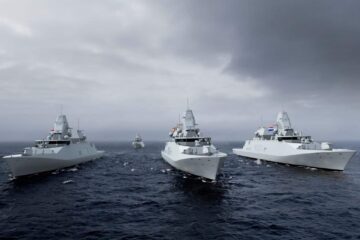The Belgian Navy’s future research vessel Belgica was launched on 11 February 2020 at the Freire Shipyard in Vigo, Spain. The delivery of the ship in Zeebrugge, Belgium, is scheduled for the last quarter of this year.
A collaboration between the Belgian MoD, the Royal Belgian Institute of Natural Sciences (RBINS), and the Federal Science Policy Office (BELSPO), this project was launched in October 2016 for a total cost of 54 million euros. The Belgian Defense will staff personnel and support at the Zeebrugge Naval Base.
« Due to climate change, new phenomena will appear in our seas and oceans. We don’t know them yet, but the Navy will have to prepare for them. This can only be done by remaining closely associated with scientific research and the models built on this basis. »
Admiral Yves Dupont, head of the Belgian Navy Systems Division.
Although the North Sea will remain its main prospecting area, the ship’s missions will extend further than the current Belgica. Namely: to the north to above the Arctic Circle, and to the south including the Mediterranean, the Black Sea and the western part of the Atlantic Ocean. The ship will have an endurance of 30 days and will carry out up to 300 days of search at sea each year.
The Belgica RV is much more larger than its predecessor, the A 962 Belgica vessel. Thanks to the doubling of the space reserved for the laboratory, it will accommodate up to 28 international scientists.
The future Belgica RV will now be equipped with scientific equipment which will, among other missions, allow samples to be taken at depths of up to 5,000 meters. This vessel will also be equipped with a slight reinforcement against ice in order to be able to conduct research in arctic areas during summer.
Belgica RV Specifications

Specifications:
- Length: 71.40 m
- Width: 16.80m
- Draft: 4.80 m
- Autonomy: 30 days
- Number days at sea: approximately 300 days / year
- Capacity for scientists and crew: 28 + 12
- Multipurpose research vessel: fisheries, geology, chemistry, biology, oceanography etc
- Study area: latitude 80° north (Spitsbergen) and latitude 28° north, bounded in the west by the mid-Atlantic ridge and in the east by longitude 36° east including the Mediterranean.
- Possibility of using AUVs (autonomous underwater vehicles), ROVs (remote-controlled vehicles), tripods, buoys and other scientific equipment to be put at sea
- Possibility to do research at water depths of 5000 m
- Dynamic Positioning Class 2
- Acoustically Silent (DNV-GL Silent R)
- Ice Reinforcement Class ICE-1C
- 2 dropkeels
- Laboratory space(> 400m²): 5 dry labs, 3 wet labs, one scientific coordination and data acquisition room
- Space for containers (7 * ISO20 containers).






